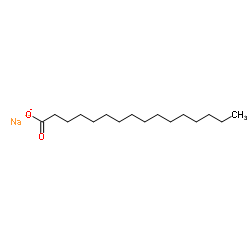Palmitic acid sodium

Palmitic acid sodium structure
|
Common Name | Palmitic acid sodium | ||
|---|---|---|---|---|
| CAS Number | 408-35-5 | Molecular Weight | 278.406 | |
| Density | N/A | Boiling Point | 340.6ºC at 760mmHg | |
| Molecular Formula | C16H31NaO2 | Melting Point | 283-290 °C(lit.) | |
| MSDS | Chinese USA | Flash Point | 154.1ºC | |
| Symbol |

GHS07 |
Signal Word | Warning | |
|
Thermogenic activity of UCP1 in human white fat-derived beige adipocytes.
Mol. Endocrinol. 29(1) , 130-9, (2014) Heat-producing beige/brite (brown-in-white) adipocytes in white adipose tissue have the potential to suppress metabolic disease in mice and hold great promise for the treatment of obesity and type 2 diabetes in humans. Here, we demonstrate that human adipose-... |
|
|
HC toxin (a HDAC inhibitor) enhances IRS1-Akt signalling and metabolism in mouse myotubes.
J. Mol. Endocrinol. 55 , 197-207, (2015) Exercise enhances numerous signalling pathways and activates substrate metabolism in skeletal muscle. Small molecule compounds that activate these cellular responses have been shown to recapitulate the metabolic benefits of exercise. In this study, a histone ... |
|
|
Phosphorylation of caveolin-1 on tyrosine-14 induced by ROS enhances palmitate-induced death of beta-pancreatic cells.
Biochim. Biophys. Acta 1852(5) , 693-708, (2015) A considerable body of evidence exists implicating high levels of free saturated fatty acids in beta pancreatic cell death, although the molecular mechanisms and the signaling pathways involved have not been clearly defined. The membrane protein caveolin-1 ha... |
|
|
Oligonol suppresses lipid accumulation and improves insulin resistance in a palmitate-induced in HepG2 hepatocytes as a cellular steatosis model.
BMC Complement Altern. Med. 15 , 185, (2015) Oligonol is a low molecular weight form of polyphenol polymers derived from lychee fruits. Several studies suggest that Oligonol has an anti-obesity effect. Since obesity is tightly associated with insulin resistance, we investigated a possible remission effe... |
|
|
Structural modification of resveratrol leads to increased anti-tumor activity, but causes profound changes in the mode of action.
Toxicol. Appl. Pharmacol. 287 , 67-76, (2015) (Z)-3,5,4'-Trimethoxystilbene (Z-TMS) is a resveratrol analog with increased antiproliferative activity towards a number of cancer cell lines compared to resveratrol, which has been shown to inhibit tubulin polymerization in vitro. The purpose of this study w... |
|
|
Autophagy facilitates secretion and protects against degeneration of the Harderian gland.
Autophagy 11(2) , 298-313, (2015) The epithelial derived Harderian gland consists of 2 types of secretory cells. The more numerous type A cells are responsible for the secretion of lipid droplets, while type B cells produce dark granules of multilamellar bodies. The process of autophagy is co... |
|
|
MicroRNA-195 inhibits proliferation, invasion and metastasis in breast cancer cells by targeting FASN, HMGCR, ACACA and CYP27B1.
Sci. Rep. 5 , 17454, (2015) De novo lipogenesis, a hallmark for cancers is required for cellular transformation. Further it is believed that resistance to apoptosis and epithelial-to-mesenchymal-transition(EMT) facilitates metastasis via over-expression of anti-apoptotic Bcl-2. Previous... |
|
|
Solid lipid nanoparticles for potential doxorubicin delivery in glioblastoma treatment: preliminary in vitro studies.
J. Pharm. Sci. 103(7) , 2157-65, (2014) The major obstacle to glioblastoma pharmacological therapy is the overcoming of the blood-brain barrier (BBB). In literature, several strategies have been proposed to overcome the BBB: in this experimental work, solid lipid nanoparticles (SLN), prepared accor... |
|
|
Sab (Sh3bp5) dependence of JNK mediated inhibition of mitochondrial respiration in palmitic acid induced hepatocyte lipotoxicity.
J. Hepatol. 62 , 1367-74, (2015) Sustained c-Jun N-terminal kinase (JNK) activation by saturated fatty acids plays a role in lipotoxicity and the pathogenesis of non-alcoholic steatohepatitis (NASH). We have reported that the interaction of JNK with mitochondrial Sab leads to inhibition of r... |
|
|
Application of magnetic iron oxide nanoparticles for the analysis of PCBs in water and soil leachates by gas chromatography-tandem mass spectrometry.
Anal. Bioanal. Chem 407(7) , 1913-24, (2015) Two magnetic solid-phase extraction methods (mSPE) were developed and compared for the extraction and preconcentration of polychlorinated biphenyls (PCBs) from water and soil leachates. Analyses were carried out by gas chromatography coupled to triple quadrup... |